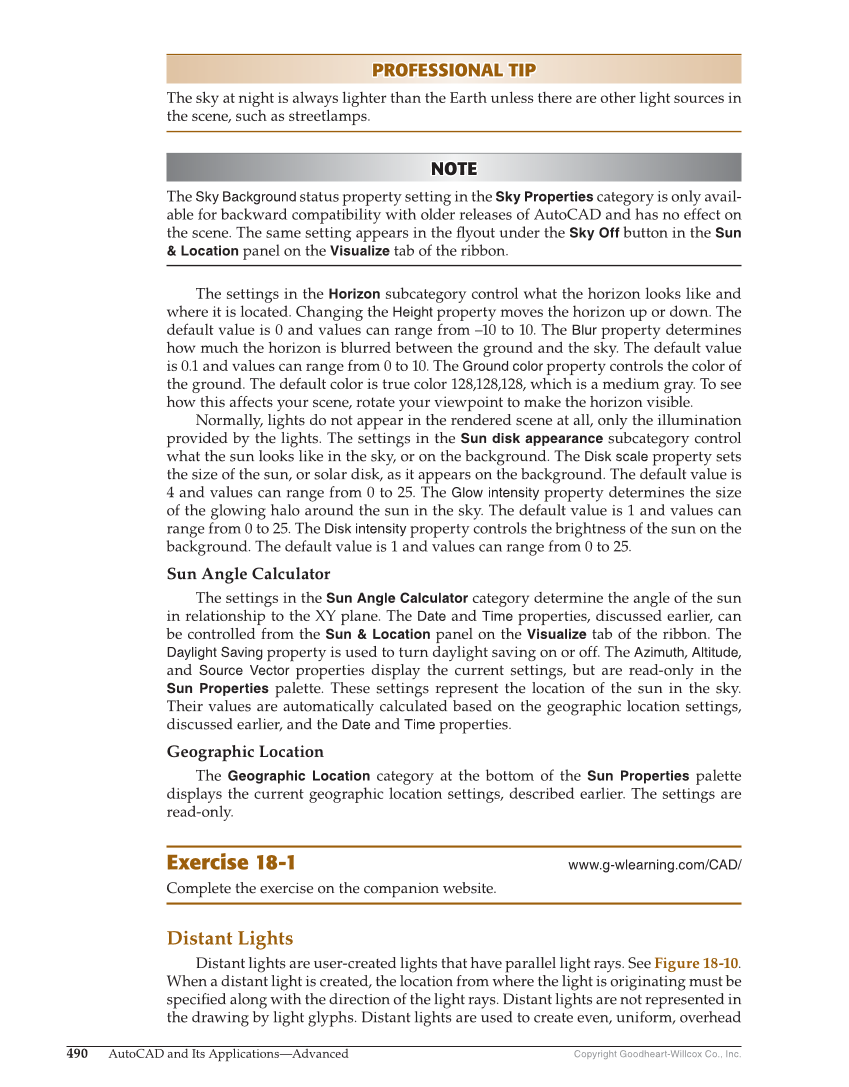Copyright Goodheart-Willcox Co., Inc. 490 AutoCAD and Its Applications—Advanced PROFESSIONAL TIP PROFESSIONAL TIP The sky at night is always lighter than the Earth unless there are other light sources in the scene, such as streetlamps. NOTE NOTE The Sky Background status property setting in the Sky Properties category is only avail- able for backward compatibility with older releases of AutoCAD and has no effect on the scene. The same setting appears in the fl yout under the Sky Off button in the Sun & Location panel on the Visualize tab of the ribbon. The settings in the Horizon subcategory control what the horizon looks like and where it is located. Changing the Height property moves the horizon up or down. The default value is 0 and values can range from –10 to 10. The Blur property determines how much the horizon is blurred between the ground and the sky. The default value is 0.1 and values can range from 0 to 10. The Ground color property controls the color of the ground. The default color is true color 128,128,128, which is a medium gray. To see how this affects your scene, rotate your viewpoint to make the horizon visible. Normally, lights do not appear in the rendered scene at all, only the illumination provided by the lights. The settings in the Sun disk appearance subcategory control what the sun looks like in the sky, or on the background. The Disk scale property sets the size of the sun, or solar disk, as it appears on the background. The default value is 4 and values can range from 0 to 25. The Glow intensity property determines the size of the glowing halo around the sun in the sky. The default value is 1 and values can range from 0 to 25. The Disk intensity property controls the brightness of the sun on the background. The default value is 1 and values can range from 0 to 25. Sun Angle Calculator The settings in the Sun Angle Calculator category determine the angle of the sun in relationship to the XY plane. The Date and Time properties, discussed earlier, can be controlled from the Sun & Location panel on the Visualize tab of the ribbon. The Daylight Saving property is used to turn daylight saving on or off. The Azimuth, Altitude, and Source Vector properties display the current settings, but are read-only in the Sun Properties palette. These settings represent the location of the sun in the sky. Their values are automatically calculated based on the geographic location settings, discussed earlier, and the Date and Time properties. Geographic Location The Geographic Location category at the bottom of the Sun Properties palette displays the current geographic location settings, described earlier. The settings are read-only. Exercise 18-1 www.g-wlearning.com/CAD/ Complete the exercise on the companion website. Distant Lights Distant lights are user-created lights that have parallel light rays. See Figure 18-10. When a distant light is created, the location from where the light is originating must be specifi ed along with the direction of the light rays. Distant lights are not represented in the drawing by light glyphs. Distant lights are used to create even, uniform, overhead
